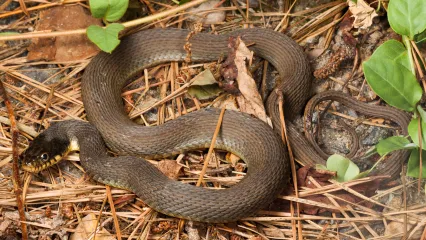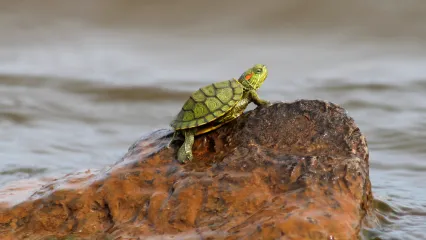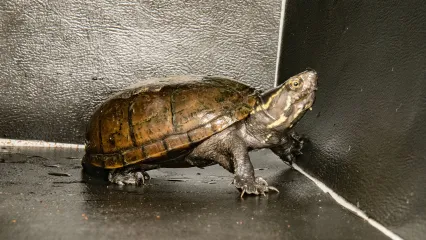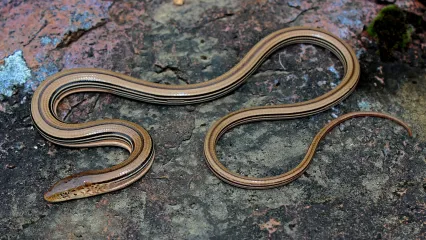
Description
Plain-bellied watersnakes are large, heavy-bodied snakes that are usually found in, near, or above (on tree branches or shrubs) water, similar to diamondback watersnakes. In western Oklahoma, they are called blotched watersnakes because their adult coloration is considerably lighter. The background color of the body is gray to olive with a series of light-colored but darker blotches that extend the full length of the body. In large adults, the pattern can be faded to the point that it is indistinct. The belly is yellow with no other markings. Dorsal scales are heavily keeled.
The only remotely similar nonvenomous snake is the diamondback watersnake, which has dark markings in a chain-like pattern and a yellow belly with dark half-moon-shaped markings. Plain-bellied watersnakes can be confused with western cottonmouths, which are venomous pit vipers. All three are aquatic, found in similar places, have heavily keeled scales, and are heavy bodied. Plain-bellied watersnakes and diamondback watersnakes have round pupils in the eyes, divided scales under that tail, and lack a pit structure between the eyes and nostril. Western cottonmouths have elliptical pupils in the eyes and complete scales under the tail.
Size
Adults vary from about 30-48 inches, but may reach nearly five feet. Newly born young are 7-12 inches in total length.
Habitat
In North America, the distribution of these watersnakes extends west to east from southeastern New Mexico to New Jersey and north to south from central Michigan into Mexico.
Life Cycle
Plain-bellied watersnakes are primarily aquatic but often move away from water both during and after rain storms. During spring, it is common to find these snakes coiled or stretched out well away from banks of ponds and streams basking in the sun. They are associated with nearly all wetlands, including rivers, streams, ponds, oxbow lakes, lakes, and boggy areas. Similar to diamondback watersnakes, they often overwinter in large numbers inside of beaver dams and can be found basking on the dams in very early spring. Also, similar to diamondback watersnakes, they often bask on limbs that overhang water, dropping off into the water when disturbed.
Mating occurs in early spring. These live-bearing snakes produce young from mid-July through early November, but most are born during September. The number of offspring varies with female body size with small females producing as few as two to as many as 55 young. These snakes appear to be active during the day and night and are active earlier in spring than other watersnakes. Plain-bellied watersnakes primarily eat frogs and tadpoles, but occasionally take fish and crayfish. Plain-bellied watersnakes are harmless to humans.
How To Observe
These conspicuous snakes can be observed in spring by walking a short distance away from shorelines and searching the ground. They frequently bask in sun in open patches and when disturbed escape into the water. At night they can be easily found by searching in water with headlights.
(This profile was created by Dr. Laurie Vitt as part of a partnership between the Wildlife Department and the Sam Noble Oklahoma Museum of Natural History. It was funded as part of a larger State Wildlife Grant to survey and inventory amphibians and reptiles of the Wildlife Management Areas of Oklahoma: T-35-P-1.)


